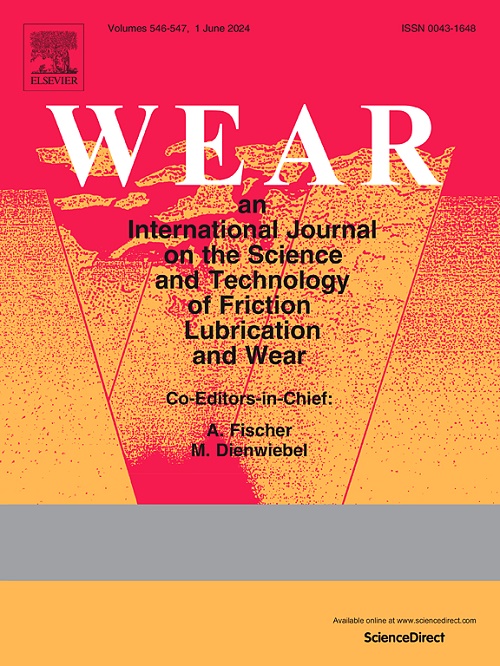Experimental studies of rolling and rolling-sliding contact fatigue behaviour of high nitrogen alloyed Cronidur-30 bearing steel
IF 5.3
1区 工程技术
Q1 ENGINEERING, MECHANICAL
引用次数: 0
Abstract
This study analyzes the rolling and rolling-sliding contact fatigue behavior of Cronidur-30, an advanced nitrogen-alloyed steel tempered at high and low temperatures, with a comparative analysis against AISI 440C. The experiments were separately conducted under pure rolling (0 % slip) and rolling-sliding (0.5 % slip) conditions, using base and graphene-enhanced lubricants (GNL). Recent works among these materials revealed that the Cronidur- 30 material exhibited a longer rolling contact fatigue (RCF) life (L10 life) compared to 440C. Given the difficulties in predicting RCF L10 life under slip conditions, anti-wear performance under rolling contact fatigue conditions was evaluated by quantifying material removal during tests at zero and 0.5 % slip conditions. Compared to 440C, Cronidur-30 showed reduced anti-wear performance in both pure rolling and slip conditions with base lubrication. Although the use of GNL followed the same trend in anti-wear performance across these materials, it still showed a notable improvement over the base lubricant. In pure rolling conditions, GNL led to improved wear performance relative to the base lubricant, with 440C exhibiting the greatest improvement of 53 %, and Cronidur-30 showing a 32 % increase compared. Under slip conditions with GNL, Cronidur-30 achieved a 98 % improvement in anti-wear performance, significantly higher than the 38 % improvement observed in 440C compared to the base lubricant. This enhancement is primarily attributed to the graphene nano-additives, which reduce metal-to-metal contact and thus improve antiwear performance. The results highlight the potential of graphene nano lubricants to significantly enhance the wear resistance of aerospace steels under slip-rolling conditions.
高氮合金Cronidur-30轴承钢滚动及滚动滑动接触疲劳特性试验研究
研究了高低温调质高级氮合金钢Cronidur-30的滚动和滚动滑动接触疲劳行为,并与AISI 440C进行了对比分析。实验分别在纯滚动(0%滑移)和滚动-滑动(0.5%滑移)条件下进行,分别使用碱性和石墨烯增强润滑剂(GNL)。最近对这些材料的研究表明,与440C相比,Cronidur- 30材料具有更长的滚动接触疲劳寿命(L10寿命)。考虑到在滑移条件下预测RCF L10寿命的困难,通过量化零滑移和0.5%滑移条件下的材料去除来评估滚动接触疲劳条件下的抗磨性能。与440C相比,Cronidur-30在基础润滑的纯滚动和滑动条件下的抗磨性能都有所降低。尽管GNL的使用在这些材料的抗磨性能方面遵循相同的趋势,但与基础润滑剂相比,它仍然表现出显着的改善。在纯轧制条件下,相对于基础润滑剂,GNL改善了磨损性能,440C表现出最大的改善,提高了53%,而Cronidur-30则提高了32%。在含有GNL的滑动条件下,Cronidur-30的抗磨性能提高了98%,明显高于440C条件下与基础润滑剂相比的38%的抗磨性能。这种增强主要归功于石墨烯纳米添加剂,它减少了金属与金属的接触,从而提高了抗磨性能。研究结果表明,石墨烯纳米润滑剂可以显著提高航空航天钢在滑滚条件下的耐磨性。
本文章由计算机程序翻译,如有差异,请以英文原文为准。
求助全文
约1分钟内获得全文
求助全文
来源期刊

Wear
工程技术-材料科学:综合
CiteScore
8.80
自引率
8.00%
发文量
280
审稿时长
47 days
期刊介绍:
Wear journal is dedicated to the advancement of basic and applied knowledge concerning the nature of wear of materials. Broadly, topics of interest range from development of fundamental understanding of the mechanisms of wear to innovative solutions to practical engineering problems. Authors of experimental studies are expected to comment on the repeatability of the data, and whenever possible, conduct multiple measurements under similar testing conditions. Further, Wear embraces the highest standards of professional ethics, and the detection of matching content, either in written or graphical form, from other publications by the current authors or by others, may result in rejection.
 求助内容:
求助内容: 应助结果提醒方式:
应助结果提醒方式:


